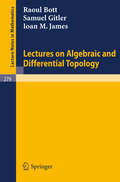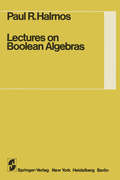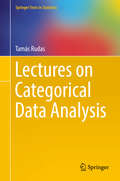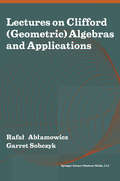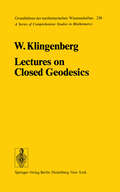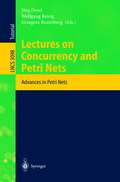- Table View
- List View
Lectures on Algebraic and Differential Topology: Delivered at the 2. ELAM (Lecture Notes in Mathematics #279)
by R. Bott S. GitlerLectures on Algebraic Geometry I: Sheaves, Cohomology of Sheaves, and Applications to Riemann Surfaces (Aspects of Mathematics #35)
by Günter HarderThis book and the following second volume is an introduction into modern algebraic geometry. In the first volume the methods of homological algebra, theory of sheaves, and sheaf cohomology are developed. These methods are indispensable for modern algebraic geometry, but they are also fundamental for other branches of mathematics and of great interest in their own. In the last chapter of volume I these concepts are applied to the theory of compact Riemann surfaces. In this chapter the author makes clear how influential the ideas of Abel, Riemann and Jacobi were and that many of the modern methods have been anticipated by them. For this second edition the text was completely revised and corrected. The author also added a short section on moduli of elliptic curves with N-level structures. This new paragraph anticipates some of the techniques of volume II.
Lectures on Algebraic Geometry I: Sheaves, Cohomology of Sheaves, and Applications to Riemann Surfaces (Aspects of Mathematics)
by Günter HarderThis book and the following second volume is an introduction into modern algebraic geometry. In the first volume the methods of homological algebra, theory of sheaves, and sheaf cohomology are developed. These methods are indispensable for modern algebraic geometry, but they are also fundamental for other branches of mathematics and of great interest in their own. In the last chapter of volume I these concepts are applied to the theory of compact Riemann surfaces. In this chapter the author makes clear how influential the ideas of Abel, Riemann and Jacobi were and that many of the modern methods have been anticipated by them.
Lectures on Algebraic Geometry II: Basic Concepts, Coherent Cohomology, Curves and their Jacobians (Aspects of Mathematics)
by Günter HarderThis second volume introduces the concept of shemes, reviews some commutative algebra and introduces projective schemes. The finiteness theorem for coherent sheaves is proved, here again the techniques of homological algebra and sheaf cohomology are needed. In the last two chapters, projective curves over an arbitrary ground field are discussed, the theory of Jacobians is developed, and the existence of the Picard scheme is proved. Finally, the author gives some outlook into further developments- for instance étale cohomology- and states some fundamental theorems.
Lectures on Algebraic Quantum Groups (Advanced Courses in Mathematics - CRM Barcelona)
by Ken Brown Ken R. GoodearlThis book consists of an expanded set of lectures on algebraic aspects of quantum groups. It particularly concentrates on quantized coordinate rings of algebraic groups and spaces and on quantized enveloping algebras of semisimple Lie algebras. Large parts of the material are developed in full textbook style, featuring many examples and numerous exercises; other portions are discussed with sketches of proofs, while still other material is quoted without proof.
Lectures on Algebraic Statistics (Oberwolfach Seminars #39)
by Mathias Drton Bernd Sturmfels Seth SullivantHow does an algebraic geometer studying secant varieties further the understanding of hypothesis tests in statistics? Why would a statistician working on factor analysis raise open problems about determinantal varieties? Connections of this type are at the heart of the new field of "algebraic statistics". In this field, mathematicians and statisticians come together to solve statistical inference problems using concepts from algebraic geometry as well as related computational and combinatorial techniques. The goal of these lectures is to introduce newcomers from the different camps to algebraic statistics. The introduction will be centered around the following three observations: many important statistical models correspond to algebraic or semi-algebraic sets of parameters; the geometry of these parameter spaces determines the behaviour of widely used statistical inference procedures; computational algebraic geometry can be used to study parameter spaces and other features of statistical models.
Lectures on Algebraic Topology (Classics in Mathematics)
by Albrecht DoldSpringer is reissuing a selected few highly successful books in a new, inexpensive softcover edition to make them easily accessible to younger generations of students and researchers. Springer-Verlag began publishing books in higher mathematics in 1920. This is a reprint of the Second Edition.
Lectures on Algebraic Topology (Grundlehren der mathematischen Wissenschaften #200)
by Albrecht DoldThis is essentially a book on singular homology and cohomology with special emphasis on products and manifolds. It does not treat homotopy theory except for some basic notions, some examples, and some applica tions of (co-)homology to homotopy. Nor does it deal with general(-ised) homology, but many formulations and arguments on singular homology are so chosen that they also apply to general homology. Because of these absences I have also omitted spectral sequences, their main applications in topology being to homotopy and general (co-)homology theory. Cech cohomology is treated in a simple ad hoc fashion for locally compact subsets of manifolds; a short systematic treatment for arbitrary spaces, emphasizing the universal property of the Cech-procedure, is contained in an appendix. The book grew out of a one-year's course on algebraic topology, and it can serve as a text for such a course. For a shorter basic course, say of half a year, one might use chapters II, III, IV (§§ 1-4), V (§§ 1-5, 7, 8), VI (§§ 3, 7, 9, 11, 12). As prerequisites the student should know the elementary parts of general topology, abelian group theory, and the language of categories - although our chapter I provides a little help with the latter two. For pedagogical reasons, I have treated integral homology only up to chapter VI; if a reader or teacher prefers to have general coefficients from the beginning he needs to make only minor adaptions.
Lectures on Amenability (Lecture Notes in Mathematics #1774)
by Volker RundeThe notion of amenability has its origins in the beginnings of modern measure theory: Does a finitely additive set function exist which is invariant under a certain group action? Since the 1940s, amenability has become an important concept in abstract harmonic analysis (or rather, more generally, in the theory of semitopological semigroups). In 1972, B.E. Johnson showed that the amenability of a locally compact group G can be characterized in terms of the Hochschild cohomology of its group algebra L^1(G): this initiated the theory of amenable Banach algebras. Since then, amenability has penetrated other branches of mathematics, such as von Neumann algebras, operator spaces, and even differential geometry. Lectures on Amenability introduces second year graduate students to this fascinating area of modern mathematics and leads them to a level from where they can go on to read original papers on the subject. Numerous exercises are interspersed in the text.
Lectures on Analysis on Metric Spaces (Universitext)
by Juha HeinonenThe purpose of this book is to communicate some of the recent advances in this field while preparing the reader for more advanced study. The material can be roughly divided into three different types: classical, standard but sometimes with a new twist, and recent. The author first studies basic covering theorems and their applications to analysis in metric measure spaces. This is followed by a discussion on Sobolev spaces emphasizing principles that are valid in larger contexts. The last few sections of the book present a basic theory of quasisymmetric maps between metric spaces. Much of the material is recent and appears for the first time in book format.
Lectures on Analytic Function Spaces and their Applications (Fields Institute Monographs #39)
by Javad MashreghiThe focus program on Analytic Function Spaces and their Applications took place at Fields Institute from July 1st to December 31st, 2021. Hilbert spaces of analytic functions form one of the pillars of complex analysis. These spaces have a rich structure and for more than a century have been studied by many prominent mathematicians. They have essential applications in other fields of mathematics and engineering. The most important Hilbert space of analytic functions is the Hardy class H2. However, its close cousins—the Bergman space A2, the Dirichlet space D, the model subspaces Kt, and the de Branges-Rovnyak spaces H(b)—have also garnered attention in recent decades. Leading experts on function spaces gathered and discussed new achievements and future venues of research on analytic function spaces, their operators, and their applications in other domains.With over 250 hours of lectures by prominent mathematicians, the program spanned a wide variety of topics. More explicitly, there were courses and workshops on Interpolation and Sampling, Riesz Bases, Frames and Signal Processing, Bounded Mean Oscillation, de Branges-Rovnyak Spaces, Blaschke Products and Inner Functions, and Convergence of Scattering Data and Non-linear Fourier Transform, among others. At the end of each week, there was a high-profile colloquium talk on the current topic. The program also contained two advanced courses on Schramm Loewner Evolution and Lattice Models and Reproducing Kernel Hilbert Space of Analytic Functions.This volume features the courses given on Hardy Spaces, Dirichlet Spaces, Bergman Spaces, Model Spaces, Operators on Function Spaces, Truncated Toeplitz Operators, Semigroups of weighted composition operators on spaces of holomorphic functions, the Corona Problem, Non-commutative Function Theory, and Drury-Arveson Space. This volume is a valuable resource for researchers interested in analytic function spaces.
Lectures on Applications-Oriented Mathematics (Wiley Classics Library #33)
by Bernard FriedmanMeets the need for a program of short courses involving the essentials of a number of mathematical topics taken by physics and engineering students. Basically applications-oriented, the courses do include selected topics of abstract mathematics. While several courses can be used as practical appendices to conventional mathematics, others serve as introductions, providing motivation for self-study in areas of conceptual math.
Lectures on Applied Mathematics: Proceedings of the Symposium Organized by the Sonderforschungsbereich 438 on the Occasion of Karl-Heinz Hoffmann’s 60th Birthday, Munich, June 30 – July 1, 1999
by Hans-Joachim Bungartz Ronald W. Hoppe Christoph ZengerWhen the DFG (Deutsche Forschungsgemeinschaft) launched its collabora tive research centre or SFB (Sonderforschungsbereich) 438 "Mathematical Modelling, Simulation, and Verification in Material-Oriented Processes and Intelligent Systems" in July 1997 at the Technische Vniversitat Munchen and at the Vniversitat Augsburg, southern Bavaria got its second nucleus of the still young discipline scientific computing. Whereas the first and older one, FORTWIHR, the Bavarian Consortium for High Performance Scientific Com puting, had put its main emphasis on the supercomputing aspect, this new initiative was now expected to focus on the mathematical part. Consequently, throughout all of the five main research topics (A) adaptive materials and thin layers, (B) adaptive materials in medicine, (C) robotics, aeronautics, and automobile technology, (D) microstructured devices and systems, and (E) transport processes in flows, mathematical aspects play a predominant role. The formation of the SFB 438 and its scientific program are inextricably linked with the name of Karl-Heinz Hoffmann. As full professor for applied mathematics in Augsburg (1981-1991) and in Munchen (since 1992) and as dean of the faculty of mathematics at the TV Munchen, he was the driv ing force of this fascinating, but not always easy-to-realize idea of bringing together scientists from mathematics, physics, engineering, informatics, and medicine for joint efforts in modern applied mathematics. However, scarcely work had begun when the successful captain was called to take command on a bigger boat.
Lectures on Boolean Algebras (Undergraduate Texts in Mathematics)
by Steven Givant P.R. HalmosIN 1959 I lectured on Boolean algebras at the University of Chicago. A mimeographed version of the notes on which the lectures were based circulated for about two years; this volume contains those notes, corrected and revised. Most of the corrections were suggested by Peter Crawley. To judge by his detailed and precise suggestions, he must have read every word, checked every reference, and weighed every argument, and I am lIery grateful to hirn for his help. This is not to say that he is to be held responsible for the imperfec tions that remain, and, in particular, I alone am responsible for all expressions of personal opinion and irreverent view point. P. R. H. Ann Arbor, Michigan ] anuary, 1963 Contents Section Page 1 1 Boolean rings ............................ . 2 Boolean algebras ......................... . 3 9 3 Fields of sets ............................ . 4 Regular open sets . . . . . . . . . . . . . . . . . . . 12 . . . . . . 5 Elementary relations. . . . . . . . . . . . . . . . . . 17 . . . . . 6 Order. . . . . . . . . . . . . . . . . . . . . . . . . . . 21 . . . . . . . . . 7 Infinite operations. . .. . . . . . . . . . . . . . . . . 25 . . . . . 8 Subalgebras . . . . . . . . . . . . . . . . . . . . .. . . . 31 . . . . . . 9 Homomorphisms . . . . . . . . . . . . . . . . . . . . 35 . . . . . . . 10 Free algebras . . . . . . . . . . . . . . . . . . . . . . 40 . . . . . . . 11 Ideals and filters. . . . . . . . . . . . . . . . . . . . 47 . . . . . . 12 The homomorphism theorem. . . . . . . . . . . . .. . . 52 . . 13 Boolean a-algebras . . . . . . . . . . . . . . . . . . 55 . . . . . . 14 The countable chain condition . . . . . . . . . . . . 61 . . . 15 Measure algebras . . . . . . . . . . . . . . . . . . . 64 . . . . . . . 16 Atoms.. . . . .. . . . . .. .. . . . ... . . . . .. . . ... . . .. 69 17 Boolean spaces . . . . . . . . . . . . . . . . . . . . 72 . . . . . . . 18 The representation theorem. . . . . . . . . . . . . . 77 . . . 19 Duali ty for ideals . . . . . . . . . . . . . . . . . .. . . 81 . . . . . 20 Duality for homomorphisms . . . . . . . . . . . . . . 84 . . . . 21 Completion . . . . . . . . . . . . . . . . . . . . . . . 90 . . . . . . . . 22 Boolean a-spaces . . . . . . . . . . . . . . . . . .. . . 97 . . . . . 23 The representation of a-algebras . . . . . . . . .. . . 100 . 24 Boolean measure spaces . . . . . . . . . . . . . .. . . 104 . . . 25 Incomplete algebras . . . . . . . . . . . . . . . .. . . 109 . . . . . 26 Products of algebras . . . . . . . . . . . . . . . .. . . 115 . . . . 27 Sums of algebras . . . . . . . . . . . . . . . . . .. . . 119 . . . . . 28 Isomorphisms of factors . . . . . . . . . . . . . .. . . 122 . . .
Lectures on Buildings: Updated and Revised
by Mark RonanIn mathematics, “buildings” are geometric structures that represent groups of Lie type over an arbitrary field. This concept is critical to physicists and mathematicians working in discrete mathematics, simple groups, and algebraic group theory, to name just a few areas. Almost twenty years after its original publication, Mark Ronan’s Lectures on Buildings remains one of the best introductory texts on the subject. A thorough, concise introduction to mathematical buildings, it contains problem sets and an excellent bibliography that will prove invaluable to students new to the field. Lectures on Buildings will find a grateful audience among those doing research or teaching courses on Lie-type groups, on finite groups, or on discrete groups. “Ronan’s account of the classification of affine buildings [is] both interesting and stimulating, and his book is highly recommended to those who already have some knowledge and enthusiasm for the theory of buildings.”—Bulletin of the London Mathematical Society
Lectures on Categorical Data Analysis (Springer Texts in Statistics)
by Tamás RudasThis book offers a relatively self-contained presentation of the fundamental results in categorical data analysis, which plays a central role among the statistical techniques applied in the social, political and behavioral sciences, as well as in marketing and medical and biological research. The methods applied are mainly aimed at understanding the structure of associations among variables and the effects of other variables on these interactions. A great advantage of studying categorical data analysis is that many concepts in statistics become transparent when discussed in a categorical data context, and, in many places, the book takes this opportunity to comment on general principles and methods in statistics, addressing not only the “how” but also the “why.” Assuming minimal background in calculus, linear algebra, probability theory and statistics, the book is designed to be used in upper-undergraduate and graduate-level courses in the field and in more general statistical methodology courses, as well as a self-study resource for researchers and professionals. The book covers such key issues as: higher order interactions among categorical variables; the use of the delta-method to correctly determine asymptotic standard errors for complex quantities reported in surveys; the fundamentals of the main theories of causal analysis based on observational data; the usefulness of the odds ratio as a measure of association; and a detailed discussion of log-linear models, including graphical models. The book contains over 200 problems, many of which may also be used as starting points for undergraduate research projects. The material can be used by students toward a variety of goals, depending on the degree of theory or application desired.
Lectures on Celestial Mechanics (Classics In Mathematics Ser.)
by Carl L. Siegel Jürgen K. MoserThe present book represents to a large extent the translation of the German "Vorlesungen über Himmelsmechanik" by C. L. Siegel. The demand for a new edition and for an English translation gave rise to the present volume which, however, goes beyond a mere translation. To take account of recent work in this field a number of sections have been added, especially in the third chapter which deals with the stability theory. Still, it has not been attempted to give a complete presentation of the subject, and the basic prganization of Siegel's original book has not been altered. The emphasis lies in the development of results and analytic methods which are based on the ideas of H. Poincare, G. D. Birkhoff, A. Liapunov and, as far as Chapter I is concerned, on the work of K. F. Sundman and C. L. Siegel. In recent years the measure-theoretical aspects of mechanics have been revitalized and have led to new results which will not be discussed here. In this connection we refer, in particular, to the interesting book by V. I. Arnold and A. Avez on "Problemes Ergodiques de la Mecanique Classique", which stresses the interaction of ergodic theory and mechanics. We list the points in which the present book differs from the German text. In the first chapter two sections on the tri pie collision in the three body problem have been added by C. L. Siegel.
Lectures on Choquet's Theorem (Lecture Notes in Mathematics #1757)
by Robert R. PhelpsA well written, readable and easily accessible introduction to "Choquet theory", which treats the representation of elements of a compact convex set as integral averages over extreme points of the set. The interest in this material arises both from its appealing geometrical nature as well as its extraordinarily wide range of application to areas ranging from approximation theory to ergodic theory. Many of these applications are treated in this book. This second edition is an expanded and updated version of what has become a classic basic reference in the subject.
Lectures on Classical and Quantum Theory of Fields
by Henryk Arodz Leszek HadaszThis textbook on classical and quantum theory of fields addresses graduate students starting to specialize in theoretical physics. It provides didactic introductions to the main topics in the theory of fields, while taking into account the contemporary view of the subject. The student will find concise explanations of basic notions essential for applications of the theory of fields as well as for frontier research in theoretical physics. One third of the book is devoted to classical fields. Each chapter contains exercises of varying degree of difficulty with hints or solutions, plus summaries and worked examples as useful. The textbook is based on lectures delivered to students of theoretical physics at Jagiellonian University. It aims to deliver a unique combination of classical and quantum field theory in one compact course.
Lectures on Clifford (Geometric) Algebras and Applications
by Rafal Ablamowicz Garret SobczykThe subject of Clifford (geometric) algebras offers a unified algebraic framework for the direct expression of the geometric concepts in algebra, geometry, and physics. This bird's-eye view of the discipline is presented by six of the world's leading experts in the field; it features an introductory chapter on Clifford algebras, followed by extensive explorations of their applications to physics, computer science, and differential geometry. The book is ideal for graduate students in mathematics, physics, and computer science; it is appropriate both for newcomers who have little prior knowledge of the field and professionals who wish to keep abreast of the latest applications.
Lectures on Closed Geodesics (Grundlehren der mathematischen Wissenschaften #230)
by W. KlingenbergThe question of existence of c10sed geodesics on a Riemannian manifold and the properties of the corresponding periodic orbits in the geodesic flow has been the object of intensive investigations since the beginning of global differential geo metry during the last century. The simplest case occurs for c10sed surfaces of negative curvature. Here, the fundamental group is very large and, as shown by Hadamard [Had] in 1898, every non-null homotopic c10sed curve can be deformed into a c10sed curve having minimallength in its free homotopy c1ass. This minimal curve is, up to the parameterization, uniquely determined and represents a c10sed geodesic. The question of existence of a c10sed geodesic on a simply connected c10sed surface is much more difficult. As pointed out by Poincare [po 1] in 1905, this problem has much in common with the problem ofthe existence of periodic orbits in the restricted three body problem. Poincare [l.c.] outlined a proof that on an analytic convex surface which does not differ too much from the standard sphere there always exists at least one c10sed geodesic of elliptic type, i. e., the corres ponding periodic orbit in the geodesic flow is infinitesimally stable.
Lectures on Complex Analytic Varieties (MN-14), Volume 14: Finite Analytic Mappings. (MN-14)
by Robert C. GunningThis book is a sequel to Lectures on Complex Analytic Varieties: The Local Paranwtrization Theorem (Mathematical Notes 10, 1970). Its unifying theme is the study of local properties of finite analytic mappings between complex analytic varieties; these mappings are those in several dimensions that most closely resemble general complex analytic mappings in one complex dimension. The purpose of this volume is rather to clarify some algebraic aspects of the local study of complex analytic varieties than merely to examine finite analytic mappings for their own sake.Originally published in 1970.The Princeton Legacy Library uses the latest print-on-demand technology to again make available previously out-of-print books from the distinguished backlist of Princeton University Press. These editions preserve the original texts of these important books while presenting them in durable paperback and hardcover editions. The goal of the Princeton Legacy Library is to vastly increase access to the rich scholarly heritage found in the thousands of books published by Princeton University Press since its founding in 1905.
Lectures on Complex Approximation
by GAIERThe theory of General Relativity, after its invention by Albert Einstein, remained for many years a monument of mathemati cal speculation, striking in its ambition and its formal beauty, but quite separated from the main stream of modern Physics, which had centered, after the early twenties, on quantum mechanics and its applications. In the last ten or fifteen years, however, the situation has changed radically. First, a great deal of significant exper~en tal data became available. Then important contributions were made to the incorporation of general relativity into the framework of quantum theory. Finally, in the last three years, exciting devel opments took place which have placed general relativity, and all the concepts behind it, at the center of our understanding of par ticle physics and quantum field theory. Firstly, this is due to the fact that general relativity is really the "original non-abe lian gauge theory," and that our description of quantum field in teractions makes extensive use of the concept of gauge invariance. Secondly, the ideas of supersymmetry have enabled theoreticians to combine gravity with other elementary particle interactions, and to construct what is perhaps the first approach to a more finite quantum theory of gravitation, which is known as super gravity.
Lectures on Complex Integration (Undergraduate Lecture Notes in Physics)
by A. O. GogolinThe theory of complex functions is a strikingly beautiful and powerful area of mathematics. Some particularly fascinating examples are seemingly complicated integrals which are effortlessly computed after reshaping them into integrals along contours, as well as apparently difficult differential and integral equations, which can be elegantly solved using similar methods. To use them is sometimes routine but in many cases it borders on an art. The goal of the book is to introduce the reader to this beautiful area of mathematics and to teach him or her how to use these methods to solve a variety of problems ranging from computation of integrals to solving difficult integral equations. This is done with a help of numerous examples and problems with detailed solutions.
